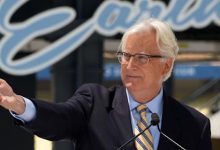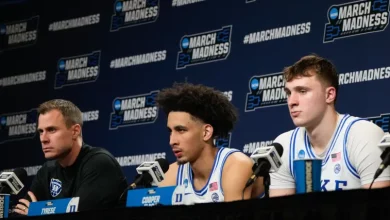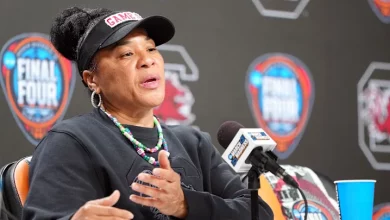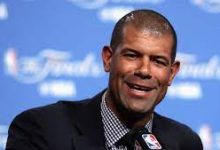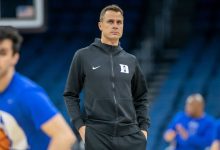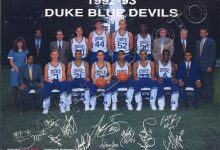Before the Banners: “He Built the Brotherhood, But Was Left Behind: The Forgotten Legend Who Made Duke Great” The jerseys of J.J. Redick, Christian Laettner, and Grant Hill are revered like holy artifacts in the corridors of Cameron Indoor Stadium. However, one name that contributed to the establishment of Duke basketball’s heyday is far too frequently overlooked: Phil Henderson.
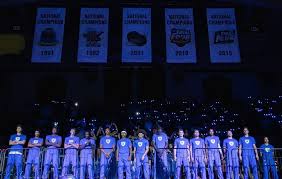
Every legend needs a foundation, and before the banners honoring Laettner, Redick, Hill, and Hurley draped Cameron Indoor’s rafters, there was Phil Henderson—the unsung architect whose contributions helped forge the early identity of Duke basketball as a national powerhouse. Henderson’s name might not roll off tongues like some of his more celebrated teammates, but he was instrumental in building the brotherhood and culture embraced under Coach K’s tenure in the late 1980s. His story deserves a deep, unflinching spotlight.
Born April 17, 1968, in Chicago, Illinois, Phil Henderson arrived at Duke in 1986 as a McDonald’s All-American, fresh from Crete‑Monee High School. Standing 6 foot 4 and weighing around 180 lb, he brought scoring prowess, versatility, and a maturity that belied his age. Under the tutelage of Mike Krzyzewski, Henderson blossomed from a skilled role player into a bonafide star, earning second‑team All‑ACC honors as a senior and Duke’s team MVP. By the time his collegiate career ended in 1990, he had tallied 1,397 points, 330 rebounds, 217 assists, and 128 three‑pointers across 115 games .
Yet Henderson’s journey to stardom wasn’t smooth. In summer 1989, after his junior season, he briefly departed Duke following an off‑court incident and contemplated transferring to Illinois. Coach K worked persistently to bring him back, reinstating him by late August in a move widely viewed as critical to Duke’s chemistry that season . When he returned, he returned determined—eager to lead and committed to the team’s ascent. Duke’s camaraderie—and ultimate success—was rooted in moments like that.
On the court, Henderson’s game spoke volumes. His senior season in 1989‑90 remains his most iconic. He started all 37 contests, averaging 18.5 ppg, 3.8 rpg, and 2.3 apg, connecting on 41.4 percent of his threes . In the ACC Tournament, he averaged 22.3 ppg, earning all‑tournament honors—and then in the NCAA East Regional, he produced masterpieces like his regional final performance against Georgetown, dropping 23 points and etching an indelible image: a soaring dunk over Alonzo Mourning that served as both artistry and intimidation .
In the NCAA Tournament’s national semifinal and final, Henderson remained a workhorse. Duke pushed past Connecticut in a tight 79‑78 OT thriller to reach the Final Four, and even in a lopsided loss to UNLV (103‑73), Henderson’s presence stood out as a rallying spirit . His scoring and consistency took the Blue Devils deeper than ever, culminating in their first national championship game appearance. Despite not bringing home the trophy, Henderson’s individual brilliance elevated the program’s national standing in a way few other players of that era matched.
Underneath statistical acclaim lay a subtler but equally vital contribution: leadership. As a senior captain, he vocalized hard truths, anchored locker-room culture, and modeled resilience. Following the dunk over Mourning, headlines buzzed nationwide, but Coach K praised the dunk less for its highlight value and more for its impact on team belief and intimidation. Henderson hadn’t just scored; he announced Duke’s arrival and invitation to elite company. His floor vision, shooting range, and defensive tenacity allowed others—like Ferry, Hill, Laettner—to flourish within the system. When Henderson dribbled into place, Duke’s offense centered around balance and execution rather than raw athleticism, reinforcing a philosophy that has defined the program ever since .
Duke’s rise in the late ’80s wasn’t built on transient flashes—it was crafted through culture. Henderson’s tenure saw Duke take three straight Final Four trips (1988, 1989, 1990), and his presence was integral in forging that identity. His scoring profile mirrors legends: career numbers—12.1 ppg, .484 FG %, .400 from deep —bookended a period where Duke matured into a dynasty. In ACC Tournament records and NCAA accolades, he’s cited repeatedly: ACC All‑Tournament (’89, ’90), NCAA All‑Regional (’89, ’90), NCAA All‑Final Four team as a senior .
Yet after college, Henderson’s trajectory took an unexpected turn. Drafted 49th overall by the Mavericks in 1990, he never broke into the NBA lineup. Instead, he played for teams like Quad City Thunder, Sioux Falls Skyforce, Fargo‑Moorhead Fever, and Tri‑City Chinook in the CBA, averaging 12.7 ppg and 2.5 rpg over five seasons . He also had stints in Belgium and Mexico, and by 1995 he transitioned into coaching and mentorship—first in the U.S., then abroad.
His genuine love for youth development shone post-retirement. He founded a basketball academy in Trinidad & Tobago, earning nine scholarships for youngsters, and later became athletic director and coach at Village High in Texas . For a period, he served at ASEAN schools in Florida and eventually settled in the Philippines, where he coached youth basketball until his sudden passing from a heart attack in February 2013 at age 44 .
“It was felt important to start the year with a united team… everybody wanted Phil back,” his former teammate Robert Brickey reflected during the 1989 reinstatement saga —a sentiment echoed by Coach K and the entire Duke family upon his death. Mike Krzyzewski described him as “a talented player and a good man with a gentle soul” and recounted the void his absence created at Cameron Indoor .
Though he never hoisted a national championship, Henderson’s legacy at Duke is no less pivotal. He was the first Duke guard in years to carry a consistent scoring load, filling the void left by Danny Ferry and setting the stage for future backcourt stars like Hurley, Dawkins, and Laettner. Duke’s culture pivoted during his era from ACC contender to national contender, and his mix of talent, heart, and leadership underpinned that shift—a precursor to the kinetic dynasties that followed.
His dunk on Mourning stands as an emblem of Duke’s transformation: a moment of pure intent, signaling arrival. Georgetown’s subsequent loss, the national attention his athletics drew, the classroom and locker room ethos he fortified—all point to a figure central to program ascension.
Still, Henderson is underrepresented in Duke lore, eclipsed by the names that followed. But those who rewatch 1989‑90 tournament footage see unmistakable echoes of his impact: his turning of wheels in clutch moments, his weathering UNLV’s pressure in the national title game, his calm seeding of younger voices. Fansided ranks him within Coach K’s top 50, highlighting him at 30: “His best season… averaged 18.5… named to the All‑ACC Second Team… ACC All‑Tournament twice… NCAA Tournament Team…” . Yet how much higher might he loom in memory?
Phil Henderson reminds us that legacies aren’t merely built on rings. They are constructed from grit, loyalty, defining moments, and lasting influence. His 18.5 ppg during his senior season, over 128 career threes, and nearly 1,400 total points only scratch the surface. His presence steered Duke toward a paradigm of discipline, execution, and national prominence. In the locker room, in the huddle, at crunch time, there was Phil—quietly asserting the principles that would shape the program’s identity.
In the years since his death, tribute pages like “We Loved Phil” and memorials in the Basketball Museum of Illinois have attempted to preserve his story . But far beyond plaques or directories, his greatest tribute lives in every Duke blueprint: synergy over stars; preparedness over flair; heart under the jersey; belief under pressure.
Before the banners, before Laettner’s all‑American breakthrough, Hill’s two‑way lighting of Cameron’s rafters, Redick’s sharpshooting, and Hurley’s floor generalship, there was Henderson—who built a brotherhood and left behind a blueprint for greatness, even if his name was left behind in legend. His is a chapter in Duke’s history that deserves more than a footnote. It demands remembrance. It deserves honor.


